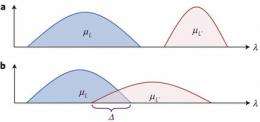May 9, 2012 weblog
Paper stirs up controversy over the nature of the quantum wave function

(Phys.org) -- Back in November, a paper posted to a preprint server arXiv by three British physicists prompted some heated debate regarding the nature of the quantum wave function, a probability function that physicists use to help them better understand the quantum world. At the time, the three refrained from joining in on subsequent discussions on the paper due to pending acceptance of the paper in the journal Nature Physics. Now that the paper has been accepted and printed, the three, Matthew Pusey, Jonathan Barrett and Terry Rudolph are openly defending their assertion that the wave function is real, not some function that is dependent on available information for the user when using it.
At the heart of the issue are the contrasting ideas on the very nature of quantum mechanics itself.
In their paper, the British physicists contend that the wave function is not just a tool that can be used for statistical purposes, but can measure actual real things. Others have suggested that it cannot be a real tool because of inconsistencies in observable quantum mechanics, such as entanglement.
Because of such inconsistencies, physicists such as Einstein contended that our knowledge or model of quantum mechanics is incomplete, not wrong. It’s possible the thinking goes, as an example, that because two distant entangled particles react in identically the same way at the same time, seemingly sharing information faster than the speed of light, that there is some new element of quantum mechanics at work that would allow for such a real world phenomenon to exist, rather than an example of the failure of quantum mechanics theory itself.
Another example is the differing views regarding Schrödinger’s cat. Some might say the wave function could be used to prove whether the unseen and thus un-measurable cat is truly dead or alive, whereas others, such as Einstein would say that because the inquisitor has only partial knowledge, no true answer can be given.
The problem with proving which view is true is the theory that most agree on and that is that quantum states can be changed simply by measuring them, which means, that as things stand now, physicists have no way of proving what state existed prior to measurement. But that doesn’t mean the wave function can’t be used to measure a quantum state, Pusey et al say, because the true state did exist before measurement occurred. At that moment it was real, they say, as is the wave function and they believe they have proved it.
More information: On the reality of the quantum state, Nature Physics (2012) doi:10.1038/nphys2309
Quantum states are the key mathematical objects in quantum theory. It is therefore surprising that physicists have been unable to agree on what a quantum state truly represents. One possibility is that a pure quantum state corresponds directly to reality. However, there is a long history of suggestions that a quantum state (even a pure state) represents only knowledge or information about some aspect of reality. Here we show that any model in which a quantum state represents mere information about an underlying physical state of the system, and in which systems that are prepared independently have independent physical states, must make predictions that contradict those of quantum theory.
via Nature News
Journal information: Nature Physics
© 2012 Phys.Org




















